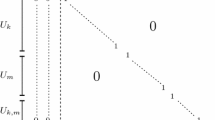Summary
In this note we present fast procedures for detecting knapsack constraint redundancy and infeasibility in 0–1 mixed integer programs by using information from probing analysis and overlapping clique identification. The new procedures improve current preprocessing techniques for size reduction of integer programs.
Similar content being viewed by others
References
Brearley, A.L., G. Mitra and H.P. Williams (1975). Analysis of mathematical programming problems prior to applying the simplex algorithm,Mathematical Programming 8, 54–83.
Crowder, H., E.L. Johnson and M.W. Padberg (1983). Solving largescale programming problems,Operations Research 31, 803–834.
Dietrich, B.L., L.F. Escudero and F. Chance (1993). Efficient reformulation for 0–1 programs, methods and computational results,Discrete Applied Mathematics 42, 147–175.
Dietrich, B.L., L.F. Escudero, A. Garín and G. Pérez (1993). O(n) procedures for identifying maximal cliques and non-dominated extensions of consecutive minimal covers and alternates,TOP 1, 139–160.
Escudero, D.F., S. Martello and P. Toth (1995). A framework for tightening 0–1 programs based on extensions of pure 0–1 knapsack and subset-sum problems, in: E. Balas and J. Clausen (eds.),Integer Programming and Combinatorial Optimization, (Springer-Verlag, Berlin), 110–123.
Guignard, M. and K. Spielberg (1981). Logical reduction methods in zero-one programming (minimal preferred variables),Operations Research 29, 49–74.
Hoffman, K.L. and M.W. Padberg (1985). LP-based combinatorial problem solving,Annals of Operations Research 4, 145–194.
Hoffman, K.L. and M.W. Padberg (1991). Improving LP representations of zero-one linear programs for branch-and-cut,ORSA Journal on Computing 3, 421–434.
Nemhauser, G.L., M.W.P. Savelsbergh and G.C. Sigismondi (1994). MINTO, a Mixed Integer Optimizer.Operational Research Letters 15, 47–58.
Nemhauser, G.L. and L.A. Wolsey (1989). Integer Programming, in: G.L. Nemhauser, A.H.G. Rinnooy Kan and M.J. Todd (eds.),Optimization (North-Holland, Amsterdam), 447–527.
Padberg, M.W. (1973). A note on zero-one programming, technical paper, New York University. See alsoOperations Research 23 (1975), 833–837.
Padberg, M.W. and G. Rinaldi (1991). A brach-and-cut algorithm for the resolution of large scale symmetric traveling salesman problems,SIAM Review 33, 60–100.
Savelsbergh, M.W.P. (1994). Preprocessing and probing techniques for mixed integer programming problems,ORSA Journal on Computing 6, 445–454.
Wolsey, L.A. (1989). Tight formulations for mixed integer programming: A survey,Mathematical Programming 45, 173–191.
Author information
Authors and Affiliations
Rights and permissions
About this article
Cite this article
Escudero, L.F., Garín, A. & Pérez, G. On using clique overlapping for detecting knapsack constraint redundancy and infeasibility in 0–1 mixed integer programs. Top 4, 87–98 (1996). https://doi.org/10.1007/BF02568605
Received:
Revised:
Issue Date:
DOI: https://doi.org/10.1007/BF02568605




